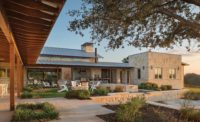

"The overall concept was to create a Western vernacular in the architecture of these buildings, and pick up on the materials that are characteristic of ranches and the natural features of the valley," said Design Architect Bill Poss, RA, president of Bill Poss and Associates Architects of Aspen, CO. "Three types of stone were used in different areas of the club."
Part of creating the western vernacular included considering the types of materials found in the environment immediately surrounding each building. "The sandstone on the lodge was chosen because it matches the native red rock outcroppings present in the mountains that form a backdrop to the project," said Kim Weil, RA, a principal at Bill Poss and Associates Architects.
"Red ledgerock sandstone was selected for the piers and base rock of the Members' Lodge because it reflects the red in the surrounding mountains," said Project Manager Chris Ridings, RA, associate of Bill Poss and Associates Architects. "River rock was used in the cabins because they are near the riverbed."
Additional natural stone helped to create a rustic mood throughout the interiors as well. For this space, stone added a local flavor to the design by including indigenous materials from the Rocky Mountain area. "We used stone as accents, as we had seen historically in this area," Poss said. "Stone supports the rustic log and timber buildings, representing the ranch homes of the valley."
A moss rock floor-to-ceiling fire-place is a focal point within the Great Room of the Members' Lodge. This fireplace was a work between the mason, the interior designers and the architects. It gives the room a warm and intimate feeling, despite the two-story ceilings and grand scale, according to the architect.
"We're trying to demonstrate that a cabin on the river would have river rock and one on the mountain would use ledge rock," said Ridings. Yet, it's not always that easy. According to Poss, the decisions made by clients are usually based on personal preference rather than what would be contextually appropriate.
The stone selections also have to take into consideration what materials are readily available. While it might seem easy enough to quarry the sandstone for the Members' Lodge from the surrounding mountains, environmental law prohibits such an action. Poss said that in many cases stone is selected to be representative of what existed on the site, but is then imported from out of state. "We try to match the stone that would have been quarried on the site for continuity and context, but we can't quarry it locally," he said. "Finding a good match for the stone often requires importing from Oklahoma, California or Arizona."
Fortunately, the architects didn't have to go for the stone used in this project. According to the stone installer, Darrell Alexander of Western Masonry Corp., the three types of stone were quarried in three different areas, the furthest of which was in Utah. "The sandstone for the exterior veneer was quarried in Torrey, UT; the mossrock, called Bear Creek Moss, was from Dove Creek, CO; and the exterior flagstone was from Lyons, CO.
Stone can be found throughout the landscape of the club as well, from the trellised flagstone patios to the decorative accent pieces on the golf course. The rustic mountain tone expands to cover the whole atmosphere of the Roaring Fork Club.
"The Lodge was very well received," said Poss. "It represents the Colorado lifestyle of ranch and cabin living and is very successful in representing the vernacular architecture of the ranch and the valley."



